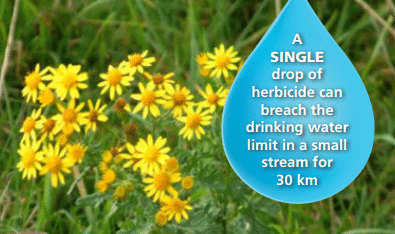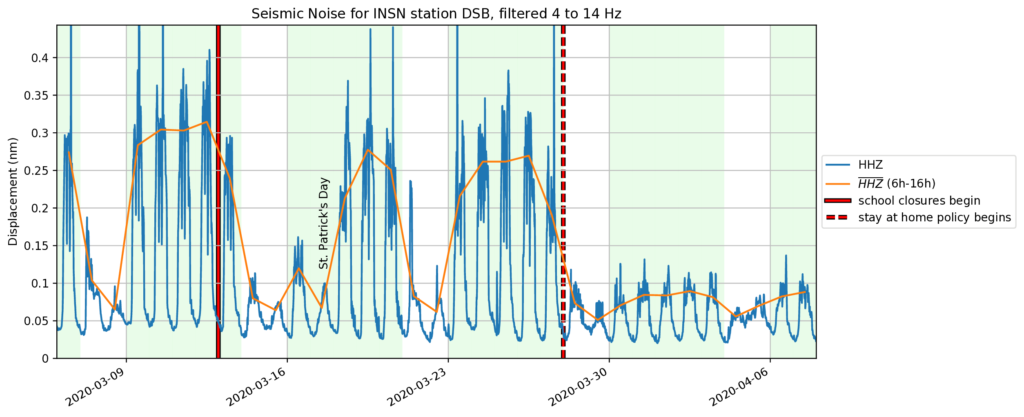
Irish Water is working at this time, with our local authority partners, contractors and others to safeguard the health and well-being of staff and the public and to ensure the continuity of drinking water and wastewater services.
Great care must always be taken to protect drinking water supplies wherever pesticide use is considered necessary, particularly if using products for grassland weed control containing substances such as MCPA, fluroxypyr and 2,4-D. These substances and others have been detected in drinking water supplies across Ireland. The detected levels sometimes exceed the legally permitted limit for pesticides in drinking water, which is set at an extremely low value (equivalent to one drop in an Olympic-sized swimming pool).
Irish Water, working in partnership with a range of organisations involved in the National Pesticides and Drinking Water Action Group (NPDWAG) is providing advice and guidance to all users of pesticides including the farming community, greens keepers and grounds keepers and domestic users, to ensure that best practice measures to protect drinking waters are always followed. Farmers and other landholders dealing with the challenge of tackling rushes should note that the Department of Agriculture, Food and the Marine (DAFM) has developed new guidance on the sustainable management of rushes. The new approach is based on the concepts of containment or suppression, and aims to minimise the use of pesticides. More information on this can be obtained from your local farm advisor or on www.pcs.agriculture.gov.ie/sud/waterprotection
There are currently six priority catchment areas of particular concern where exceedances of pesticides are persistent. These are Longford Central (MCPA), Newcastlewest (MCPA), Belturbet (MCPA), Cavan RWSS (MCPA), Clonroche (Bentazone), and Newport (Glyphosate/MCPA). All of these areas are being prioritised for action by members of the NPDWAG.
There is a separate watch list, currently comprising over 20 supplies, which is also a focus for targeted actions, since the pattern of detections in these areas indicates a risk of persistent pesticide exceedances.
The Glashaboy and Glanmire water supplies in Cork are both on the watch list for MCPA, with Glashaboy also on the list for Mecoprop and Triclopyr and Glanmire for 2 4, D and Fluroxypyr. The Macroom water supply is on the watch list for Glyphosate. The pesticide levels detected in these water supplies do not pose any immediate risk to health, but it is imperative that users of pesticides in these areas are mindful of best practice when spraying their lands.
Efforts to reduce the incidence of detections are being coordinated by the NPDWAG, which is chaired by the DAFM. All of the key stakeholders are represented in this group and include other Government departments and agencies; local authorities; industry representative bodies; farming organisations; water sector organisations; and amenity sector organisations.
Commenting, Deirdre O’Loughlin, Irish Water’s Regional Drinking Water Compliance Specialist said: “At a time of significant challenges for farmers and other essential workers managing land, we are asking everyone to continue to be mindful to protect the water bodies.
“While MCPA accounted for the majority (63 per cent) of pesticide exceedances detected nationally in public water supplies during 2019, Irish Water routinely tests for a wide range of pesticides and is closely monitoring the situation for pesticides other than MCPA. Irish Water is continuing its extensive investment programme to safeguard the water supply for homes, farms and businesses in Ireland.
“Providing safe, clean drinking water for all is our first priority. In Ireland, the majority (82 per cent) of drinking water supplies come from surface water sources such as rivers, lakes and streams. The Glashaboy, Glanmire and Macroom water supplies are vulnerable to contamination from land and animal run-off. Irish Water asks users of pesticide products in the Glashaboy River, Butlerstown River and Sullane River catchments to consider the vulnerability of the Glashaboy, Glanmire and Macroom drinking water supplies to pesticide contamination and the importance of this supply to the local communities in these areas.”
Dr Aidan Moody, Chair of the NPDWAG commented: “A lot of good work has been done and progress has been made. The continued engagement of all stakeholders, working in partnership, is needed to make further progress. Users of pesticides should always consider in the first instance if there are alternative non-chemical weed/pest control methods that would be feasible. If pesticides have to be applied users must make sure that they are aware of and follow best practice measures to protect water quality.”
MCPA, which is commonly used to kill rushes on wet land, is the main offender, however, other pesticides such as 2,4-D, fluroxypyr and MCPP (also known as mecoprop) are being detected more frequently than in previous years. Careless storage, handling or improper application of any pesticide product can easily result in traces ending up in drinking water, leading to breaches of the drinking water regulations. Users of pesticides are asked to carefully consider how these products may access water courses via rainwater drains, drainage channels or other means before application.
The regulations are so stringent that a single drop of pesticide is enough to breach the drinking water limit in a small stream for up to 30 kilometres. This clearly highlights the level of care needed to protect drinking water sources.
Irish Water working in partnership with the National Pesticides and Drinking Water Action Group would like to remind farmers and professional users of pesticides of the need to follow best practice in the application of pesticides, particularly near lakes and rivers used as drinking water sources.
If pesticides have to be used, the basic steps in reducing risks are –
- Choose the right pesticide product (Note that products containing MCPA are NOT approved for use in weed-wipers.)
- Read and follow the product label
- Determine the right amount to purchase and use
- Don’t spray if rain or strong wind is forecast in the next 48 hours
- Make sure you are aware of the location of all nearby water courses
- Comply with any buffer zone specified on the product label to protect the aquatic environment. Mark out the specified buffer zone from the edge of the river or lake or other water course
- Never fill a sprayer directly from a water course or carry out mixing, loading or other handling operations beside a water course
- Avoid spills, stay well back from open drains and rinse empty containers 3 times into the sprayer.
- Store and dispose of pesticides and their containers properly.
A recently produced video on the correct use of MCPA can be viewed on Irish Water’s YouTube channel at https://youtu.be/xQqtZ7jifUs
Information leaflets on pesticide use are also available to download from the Teagasc website at www.teagasc.ie/environment/water-quality/farming-for-water-quality-assap/improving-my-water-quality/protecting-drinking-water-from-pesticides/


